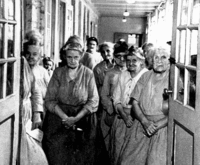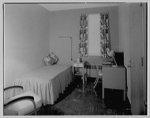Why do we fear nursing homes?
The simple answer? How and why nursing homes were originally created continues to fuel this fear.
A little over a century ago, if you needed a place to live because you were poor or disabled you were sent to a poorhouse. Though poorhouses are documented as far back as the 1600’s. The first documented poorhouse in America was in 1731. Overtime, people realized that some groups needed special care. Asylums were built to house the feeble-minded, epileptics, criminally insane, blind and deaf and tuberculosis patients. These poorhouses were paid for through taxes and housed anyone type of person; disabled, elderly, drunkards, paupers, criminally insane, and people born with cognitive disabilities.
These homes were self-sustaining, were the inmates were required to farm the land and care for the cattle.

Inmates at poorhouse.
These places were odious, filthy homes, overrun by rats and bugs. When you moved in, you were separated from your spouse, placed in a bare room and put to work. They were more lenient with the elderly, but you still had to work. Chances were you would die from infection, disease, or malnutrition. The superintendent was given authority to use ‘reasonable and human’ coercion as necessary.
Some were temporary inmates, only there to heal from illness or injury.
In the 1930’s there was an outcry on how the elderly disabled were being treated. “Nearly all county poorhouses have some aged persons who show definite symptoms of mental deterioration and may be
classified as senile insane. The question arises as to whether these persons are the responsibility of state institutions, maintained for the care of those suffering from mental disorders, or
are the responsibility of the counties. “(1)
“However, the senile insane should not he cared for in a poorhouse unless the institution is so arranged, equipped, and staffed that they can be segregated in comfortable quarters and can be given care suited to their needs. At the present time few county poorhouses have either facilities adequate to care for the senile aged apart from the other inmates or a staff which understands the care of mental patients. Patients suffering from mental disorders, who are in need of treatment in hospitals for mental diseases, should not be cared for in poorhouses and should not be confused with the senile insane who need only custodial care.” (1)
Here is an account of the quarters at a Kansas poorhouse:
‘The poorhouse is located on a large farm, several miles from a small Kansas town. The road from this town is not hard surfaced, and often is impassable in rainy weather.
Due to the condition of the dirt road, it sometimes is impossible for a doctor to attend cases at the poorhouse for days at a time.
The house, a rambling two-story frame building, constructed in the 1860’s as a poorhouse, is not in good repair.
Boxes of portulaca decorate the porch, and one end of it is shaded by a vine, There are no chairs on the porch, and the inmates are forbidden to sit there because they cannot be seen from the superintendent’s cottage and, hence, cannot be supervised. The lower floor consists of the
living room, dining room, kitchen, bedrooms, and a cell room. The second floor consists of bedrooms and a store room.
The older women inmates who are feeble use the downstairs bedrooms. One room, which is painted a bright blue, contains no furniture except a bed on which there were, at the time of the visit, during the summer, no sheets, but only a pair of gray· cotton blankets, a heavy comforter,
and a pillow. The inmate who occupies this room said that she would like to have sheets but that she had not been given any. There are no curtains at the windows and only one window has a shade. Old dresses and soiled underclothing are hung over the lower half of the window, but through the upper half the sun streams in so that the room is unbearably hot in summer. No rugs are on the bare
pine floors and no pictures hang on the walls.
‘The inhumane treatment accorded many of the infirm and bedridden inmates in some poorhouses is almost unbelievable. When helpless, ill, feeble, old men in one poorhouse were
unable to take care of themselves, attendants placed them on chairs and bathed them by turning the hose on them.
One nurse reported that when she was off duty one hot afternoon and evening, the bed patients were given no care during her absence, not even a drink of water. Another nurse reported
that she was ordered by the superintendent to give narcotics to certain patients to keep them quiet and that she had followed directions although she was worried about doing so without a doctor’s order. The following remark to a nurse, requesting supplies, is indicative of one matron’s attitude toward the inmates, “Do the best you can; we are not expected to care for these people like they do at hospitals; they are nothing but paupers anyway.”
Tasks frequently performed by inmates are cleaning, laundry work, ironing, cooking, cobbling, sewing and mending, gardening, repair work and nursing. Whether or not nursing services should be performed by inmates is questionable but if nursing duties are assigned to them they should be performed only under the close supervision of a nurse or an attendant. Very frail persons, who have difficulty in walking about, sometimes are assigned the care of bedridden patients.
In 1935, as a part of his new deal, President Roosevelt enacted the Social Security Act designed to help the elderly stay in their homes longer. An aide and grant program was created for those that did not qualify for Social Security, but could not be used or received in an institutional setting. FDR was determined to close the institutions for good. The one thing he didn’t take into consideration was that not all elderly could stay in their homes.
So when did theses homes start closing? This is where traditional nursing homes come to play. In the 1950’s, modern medicine was a booming industry and communities could not build hospitals quick enough. The doctors were the stars of the show and patients felt comfortable getting their care. As the hospitals opened, the poorhouses sent their inmates to the hospitals, creating an overcrowding situation. Hospitals lobbied the government for grants to build attached structures to place patients needing long-term care. These wings were not created to care for people, but to dump them. “Park and Die.”
Shortly after the government created rules for hospitals, they did not meet the current regulations, but there were loop-holes for nursing homes. In the 60’s and 70’s, nursing homes were cropping up all over the country, designed to ‘care’ for the feeble minded and frail population. The one area that was killing the elderly, the buildings themselves. The buildings were not designed with safety in mind and many died from fires and infection. The Federal Government began to place stricter regulations designed to create a safer environment, but not for the actual care of the human being.

1950’s nursing home room

Newspaper Article about Nursing Home Fire
In the 1970’s and 80’s, continued reports of neglect and abuse are being reported by family members of patients residing these facilities. Infections, bedsores, boredom, loneliness, and physical neglect are reported. Nursing home staff could use restraints, physical or chemical, to subdue a resident in the name of their own safety. In 1987, The Nursing Home Reform Act was put into law. This list of regulations was created to help curb neglect, but focuses on the physical body, not the emotional well-being of the residents in their care. I should note that nursing homes are the second most regulated industry in America under nuclear power. Does this equate to improved quality of life?
Traditional nursing home environments are considered smelly, cold, institutional, rigid scheduling, short staffed, and completely clinically focused. When we focus completely on the physical body, we tend to treat the them as human beings. Combine this human behavior with the lack of education and societies view on aging or ageism; our human tendency is to create a world where the resident loses control of their own lives. With that control they lose their privacy, dignity, autonomy and respect. Societies view on aging is that once you reach a certain age, you no longer have control.
It is the continued stories of abuse and aggregation that continues to breed fear in the hearts of many in our aging population.
The good news: the culture is changing. Organizations such as The Eden Alternative and Pioneer Network are pushing at the highest levels of government to create lasting change for those that need long-term care. Homes that practice culture change put the person’s well-being first, creating care plans that are person-centered and person-directed, the family and the residents have complete involvement. Residents maintain the right to make choices for themselves, be members of committees and teams, and even participate in the hiring of staff.
Culture change homes educate staff on the rights of residents making choices for themselves, when to go to bed, when to rise, when and what to eat, what to wear and even what activities to do. Staff are educated on communicating effectively with residents with cognitive disabilities, without the use of physical or chemical restraints.
So what should you be looking for in a nursing home?
- Is the building home-like? This means that institutional feeling is absent. Nursing stations should be removed, the home should be comfortable, have live plants and even pets.
- How does it smell? A home smells like home. Not chemicals or feces.
- Look at the activities. Is their access to leisure items when the director is unavailable? Is the calendar rich in meaning, or are the events mainly BINGO, sing-a-longs, and movies? Is there continued and easy access for those living with dementia? Some homes do not have a dedicated memory care wing. Dementia residents are often overlooked in activities.
- If there is a dedicated memory care, is there opportunities for consistent engagement? Residents should not be wandering aimlessly, bored? Are they parked in front of the TV to sleep?
- Are there rigid schedules? Do the residents have to be up at the same time for meals? Are they expected to go to bed early in the evening? What about the shower schedule? Do they have a choice of when to shower or bath? Even if there is a schedule, the resident has the right to change it to meet their needs.
- Listen to the facility? Is their overhead paging, call-bells, crying residents or rowdy staff? The staff should be wearing radios, call lights are silent, and staff should be handling the needs of the residents to keep them from calling out.
- How do people interact with each other? Are they friendly or do they ignore each other as they pass by. Do they talk to the residents or do they ignore them.
- Remember, a beautiful building does not always equal great care. A beautiful building can feel cold and institutional while an older home feels warm and homey.
- Take the time to tour on the weekend and see how people act. Often times the weekend staff let things go without leadership to guide them. Staff should be empowered to make decisions without a department head.
- Finally, check out the dining room. How does the food look, smell, taste? Our day revolves around food and the dining experience is the center of our day, just like home.
References: (1) The Study of Kansas Poor Farms, 1935.
Eden Alternative: www.edenalt.org
Pioneer Network: www.pioneernetwork.net
Heather Reynolds is a nationally certified Alzheimer’s Dementia Practitioner Trainer, Certified Eden Educator, and licensed nursing home administrator.
